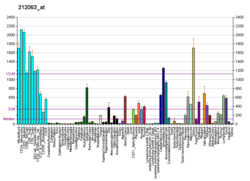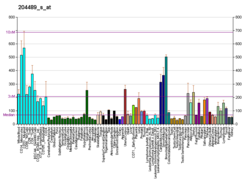CD44
CD44は、細胞間相互作用、細胞接着、遊走に関与する細胞表面糖タンパク質である。ヒトでは、CD44は11番染色体に位置するCD44遺伝子にコードされる[5]。CD44はHCAM(homing cell adhesion molecule)、 Pgp-1(phagocytic glycoprotein-1)、 Hermes抗原(Hermes antigen)、lymphocyte homing receptor、ECM-III、 HUTCH-1といった名称で呼ばれることもある。
組織分布とアイソフォーム
[編集]CD44は哺乳類の多くの細胞種で発現している。大部分の細胞種で発現している標準的なアイソフォームはCD44sと表記され、エクソン1–5と16–20から構成される。その他異なるエクソンを持つスプライスバリアントはCD44vと表記される。一部の上皮細胞では、エクソンv8–10を含む大きなアイソフォーム(CD44E)も発現している[6]。
機能
[編集]CD44はリンパ球の活性化、再循環やホーミング、造血、腫瘍の転移など広範囲の細胞機能に関係している。
CD44はヒアルロン酸受容体であるとともに、オステオポンチン、コラーゲン、マトリックスメタロプロテアーゼなど、その他のリガンドとも相互作用する。CD44の機能は翻訳後修飾によって制御されている。重要な修飾の1つとしてシアロフコシル化(sialofucosylation)があり、HCELL(Hematopoietic Cell E-selectin/L-selectin Ligand)と呼ばれるセレクチン結合型グリコフォームが形成される[7]。
CD44遺伝子の転写産物は複雑な選択的スプライシングを受け、機能的に異なる多くのアイソフォームが形成される。選択的スプライシングはCD44タンパク質の構造的・機能的多様性の基礎となっており、がんの転移と関係している可能性もある。結腸がん細胞においてCD44のスプライスバリアントは、がん転移過程と関係した血流条件下でP-、L-、E-セレクチンのリガンド、そしてフィブリン(フィブリノゲンではない)の受容体として機能する、シアロフコシル化HCELLグリコフォームを発現する[8][9]。
HCELL
[編集]HCELLグリコフォームはもともとヒト造血幹細胞と白血病性芽球から発見されたが[7][10][11][12]、その後がん細胞でも同定された[9][13][14][15][16]。HCELLは骨へのホーミングレセプターとして機能し、ヒト造血幹細胞や間葉系幹細胞の骨髄への遊走を指揮する[11]。Ex vivoでの生細胞表面の糖鎖エンジニアリングによって、いかなる細胞でもCD44を強制的に発現させることができる[17]。また、CD44のグリコシル化によってフィブリンやフィブリノゲンへの結合能は直接的に制御される[8][18]。
臨床的意義
[編集]白血病細胞上に高レベルで発現しているCD44は、白血病の発症に必要不可欠である[19]。また、CD44の特定のバリアントは頭頸部扁平上皮がんのプログレッションとも関係している[20][21]。選択的スプライシングや翻訳後修飾によって、おそらく腫瘍特異的なものも含めて、多くの異なる配列を持つCD44が産生されるため、抗CD44腫瘍特異的医薬品は現実的な治療アプローチとなる可能性がある[22]。
一方で、多くのがん(腎臓がんと非ホジキンリンパ腫は除く)において、CD44の高レベルの発現は常に転帰不良と関係しているわけではない[23]。反対に一部の新生物では、CD44のアップレギュレーションは転帰良好と関係している。このことは前立腺がんに当てはまり、CD44v5バリアント(v5エクソンが含まれている)は予後の良さ(手術後の再発期間の増加)と関係している[23][24]。前立腺がんでは、選択的スプライシングによるv5エクソンの除去にはRNA結合タンパク質KHDRBS1の存在が関係しており、YTHDC1もしくはMTDHの発現が増加している場合にはv5エクソンが組み込まれる[24]。また、CD44の発現は上皮性卵巣がんにおいても患者の生存期間の増加の指標となる[25]。
その他の疾患の場合には、異なる研究グループによる同じ腫瘍性疾患の解析によって、CD44の発現と疾患の予後の相関に関して矛盾する結果が得られており、おそらく解析手法の差異が原因となっていると考えられる。抗CD44治療をヒトのがんに対して適用する前に、まずこうした問題の解消が必要である[23]。
子宮内膜症の女性の子宮内膜細胞では、CD44の特定のスプライスバリアントの発現の上昇と腹腔細胞への接着の増加が観察される[26]。
相互作用
[編集]CD44は次に挙げる因子と相互作用することが示されている。
出典
[編集]- ^ a b c GRCh38: Ensembl release 89: ENSG00000026508 - Ensembl, May 2017
- ^ a b c GRCm38: Ensembl release 89: ENSMUSG00000005087 - Ensembl, May 2017
- ^ Human PubMed Reference:
- ^ Mouse PubMed Reference:
- ^ “The Ina and Inb blood group antigens are located on a glycoprotein of 80,000 MW (the CDw44 glycoprotein) whose expression is influenced by the In(Lu) gene”. Immunology 64 (1): 37–43. (May 1988). PMC 1385183. PMID 2454887.
- ^ “CD44 cell adhesion molecules”. Molecular Pathology 52 (4): 189–96. (Aug 1999). doi:10.1136/mp.52.4.189. PMC 395698. PMID 10694938.
- ^ a b “Detection of an L-selectin ligand on a hematopoietic progenitor cell line”. Blood 84 (10): 3299–306. (Nov 1994). doi:10.1182/blood.V84.10.3299.3299. PMID 7524735.
- ^ a b c “The dual role of CD44 as a functional P-selectin ligand and fibrin receptor in colon carcinoma cell adhesion”. American Journal of Physiology. Cell Physiology 294 (4): C907–16. (Apr 2008). doi:10.1152/ajpcell.00463.2007. PMID 18234849.
- ^ a b “CD44 on LS174T colon carcinoma cells possesses E-selectin ligand activity”. Cancer Research 65 (13): 5812–7. (Jul 2005). doi:10.1158/0008-5472.CAN-04-4557. PMID 15994957.
- ^ “A hematopoietic cell L-selectin ligand that is distinct from PSGL-1 and displays N-glycan-dependent binding activity”. Blood 96 (8): 2765–74. (Oct 2000). doi:10.1182/blood.V96.8.2765. PMID 11023510.
- ^ a b “Ex vivo glycan engineering of CD44 programs human multipotent mesenchymal stromal cell trafficking to bone”. Nature Medicine 14 (2): 181–7. (Feb 2008). doi:10.1038/nm1703. PMID 18193058.
- ^ “CD44 is a major E-selectin ligand on human hematopoietic progenitor cells”. The Journal of Cell Biology 153 (6): 1277–86. (Jun 2001). doi:10.1083/jcb.153.6.1277. PMC 2192031. PMID 11402070.
- ^ “HCELL is the major E- and L-selectin ligand expressed on LS174T colon carcinoma cells”. The Journal of Biological Chemistry 281 (20): 13899–905. (May 2006). doi:10.1074/jbc.M513617200. PMID 16565092.
- ^ a b “Variant isoforms of CD44 are P- and L-selectin ligands on colon carcinoma cells”. FASEB Journal 20 (2): 337–9. (Feb 2006). doi:10.1096/fj.05-4574fje. PMID 16352650.
- ^ a b “Selectin ligand expression regulates the initial vascular interactions of colon carcinoma cells: the roles of CD44v and alternative sialofucosylated selectin ligands”. The Journal of Biological Chemistry 282 (6): 3433–41. (Feb 2007). doi:10.1074/jbc.M607219200. PMID 17135256.
- ^ a b “Carcinoembryonic antigen and CD44 variant isoforms cooperate to mediate colon carcinoma cell adhesion to E- and L-selectin in shear flow”. The Journal of Biological Chemistry 283 (23): 15647–55. (Jun 2008). doi:10.1074/jbc.M800543200. PMC 2414264. PMID 18375392.
- ^ “Glycosyltransferase-programmed stereosubstitution (GPS) to create HCELL: engineering a roadmap for cell migration”. Immunological Reviews 230 (1): 51–74. (Jul 2009). doi:10.1111/j.1600-065X.2009.00792.x. PMC 4306344. PMID 19594629.
- ^ a b “Biomolecular characterization of CD44-fibrin(ogen) binding: distinct molecular requirements mediate binding of standard and variant isoforms of CD44 to immobilized fibrin(ogen)”. The Journal of Biological Chemistry 284 (2): 1177–89. (Jan 2009). doi:10.1074/jbc.M805144200. PMC 2613610. PMID 19004834.
- ^ “High levels of the adhesion molecule CD44 on leukemic cells generate acute myeloid leukemia relapse after withdrawal of the initial transforming event”. Leukemia 25 (3): 515–526. (Mar 2010). doi:10.1038/leu.2010.281. PMC 3072510. PMID 21116281.
- ^ “CD44 variant isoforms in head and neck squamous cell carcinoma progression”. The Laryngoscope 119 (8): 1518–30. (Aug 2009). doi:10.1002/lary.20506. PMC 2718060. PMID 19507218.
- ^ “The role of CD44 in the development and prognosis of head and neck squamous cell carcinomas”. Histology and Histopathology 17 (4): 1269–81. (Oct 2002). PMID 12371152.
- ^ “Expression of variant CD44 epitopes in human astrocytic brain tumors”. Journal of Neuro-Oncology 26 (3): 165–70. (Dec 1995). doi:10.1007/bf01052619. PMID 8750182.
- ^ a b c “CD44 in cancer”. Critical Reviews in Clinical Laboratory Sciences 39 (6): 527–79. (Nov 2002). doi:10.1080/10408360290795574. PMID 12484499.
- ^ a b “The Oncogene Metadherin Interacts with the Known Splicing Proteins YTHDC1, Sam68 and T-STAR and Plays a Novel Role in Alternative mRNA Splicing”. Cancers 11 (9): 1233. (August 2019). doi:10.3390/cancers11091233. PMC 6770463. PMID 31450747.
- ^ “CD44 expression indicates favorable prognosis in epithelial ovarian cancer”. Clinical Cancer Research 9 (14): 5318–24. (Nov 2003). PMID 14614016.
- ^ “Menstrual endometrial cells from women with endometriosis demonstrate increased adherence to peritoneal cells and increased expression of CD44 splice variants”. Fertility and Sterility 93 (6): 1745–9. (Apr 2010). doi:10.1016/j.fertnstert.2008.12.012. PMC 2864724. PMID 19200980.
- ^ “Hyaluronan-mediated CD44 interaction with RhoGEF and Rho kinase promotes Grb2-associated binder-1 phosphorylation and phosphatidylinositol 3-kinase signaling leading to cytokine (macrophage-colony stimulating factor) production and breast tumor progression”. The Journal of Biological Chemistry 278 (32): 29420–34. (Aug 2003). doi:10.1074/jbc.M301885200. PMID 12748184.
- ^ “Phosphatidylinositol 4,5-bisphosphate clusters the cell adhesion molecule CD44 and assembles a specific CD44-Ezrin heterocomplex, as revealed by small angle neutron scattering”. The Journal of Biological Chemistry 290 (10): 6639–52. (Mar 2015). doi:10.1074/jbc.M114.589523. PMC 4358296. PMID 25572402.
- ^ “TGF-β1-stimulated fibroblast to myofibroblast differentiation is mediated by HA-facilitated EGFR and CD44 co-localization in lipid rafts”. The Journal of Biological Chemistry 288 (21): 14824–38. (May 2013). doi:10.1074/jbc.M113.451336. PMC 3663506. PMID 23589287.
- ^ “Lymphocyte CD44 binds the COOH-terminal heparin-binding domain of fibronectin”. The Journal of Cell Biology 116 (3): 817–25. (Feb 1992). doi:10.1083/jcb.116.3.817. PMC 2289325. PMID 1730778.
- ^ a b “CD44 selectively associates with active Src family protein tyrosine kinases Lck and Fyn in glycosphingolipid-rich plasma membrane domains of human peripheral blood lymphocytes”. Blood 91 (10): 3901–8. (May 1998). doi:10.1182/blood.V91.10.3901. PMID 9573028.
- ^ “CD44 is the principal cell surface receptor for hyaluronate”. Cell 61 (7): 1303–13. (Jul 1990). doi:10.1016/0092-8674(90)90694-A. PMID 1694723.
- ^ “Signaling through CD44 is mediated by tyrosine kinases. Association with p56lck in T lymphocytes”. The Journal of Biological Chemistry 271 (5): 2863–7. (Feb 1996). doi:10.1074/jbc.271.5.2863. PMID 8576267.
- ^ “Intracellular osteopontin is an integral component of the CD44-ERM complex involved in cell migration”. Journal of Cellular Physiology 184 (1): 118–30. (Jul 2000). doi:10.1002/(SICI)1097-4652(200007)184:1<118::AID-JCP13>3.0.CO;2-Y. PMID 10825241.
- ^ “CD44 interaction with c-Src kinase promotes cortactin-mediated cytoskeleton function and hyaluronic acid-dependent ovarian tumor cell migration”. The Journal of Biological Chemistry 276 (10): 7327–36. (Mar 2001). doi:10.1074/jbc.M006498200. PMID 11084024.
- ^ “CD44Is the Signaling Component of the Macrophage Migration Inhibitory Factor-CD74 Receptor Complex”. Journal of Immunity 25 (4): 595–606. (October 2006). doi:10.1016/j.immuni.2006.08.020. PMC 3707630. PMID 17045821.
関連文献
[編集]- “The biology of CD44 and HCELL in hematopoiesis: the 'step 2-bypass pathway' and other emerging perspectives”. Current Opinion in Hematology 18 (4): 239–48. (Jul 2011). doi:10.1097/MOH.0b013e3283476140. PMC 3145154. PMID 21546828.
- “Glycosyltransferase-programmed stereosubstitution (GPS) to create HCELL: engineering a roadmap for cell migration”. Immunological Reviews 230 (1): 51–74. (Jul 2009). doi:10.1111/j.1600-065X.2009.00792.x. PMC 4306344. PMID 19594629.
- “The bone marrow is akin to skin: HCELL and the biology of hematopoietic stem cell homing”. The Journal of Investigative Dermatology 122 (5): 1061–9. (May 2004). doi:10.1111/j.0022-202X.2004.09301.x. PMID 15140204.
- “Cancer cells in transit: the vascular interactions of tumor cells”. Annual Review of Biomedical Engineering 11: 177–202. (2009). doi:10.1146/annurev-bioeng-061008-124949. PMID 19413512.
- “CD44: a multitude of isoforms with diverse functions”. Adhesion in Leukocyte Homing and Differentiation. 184. (1994). 47–63. doi:10.1007/978-3-642-78253-4_4. ISBN 978-3-642-78255-8. PMID 7508842
- “CD44: functional relevance to inflammation and malignancy”. Histology and Histopathology 17 (3): 945–50. (2003). PMID 12168806.
- “Protein 4.1 tumor suppressors: getting a FERM grip on growth regulation”. Journal of Cell Science 115 (Pt 21): 3991–4000. (Nov 2002). doi:10.1242/jcs.00094. PMID 12356905.
- “CD44: from adhesion molecules to signalling regulators”. Nature Reviews Molecular Cell Biology 4 (1): 33–45. (Jan 2003). doi:10.1038/nrm1004. PMID 12511867.
- “The role of the CD44/ezrin complex in cancer metastasis”. Critical Reviews in Oncology/Hematology 46 (2): 165–86. (May 2003). doi:10.1016/S1040-8428(02)00172-5. PMID 12711360.
外部リンク
[編集]- Indian blood group system at BGMUT Blood Group Antigen Gene Mutation Database at NCBI, NIH
- Articles at IHOP.
- Human CD44 genome location and CD44 gene details page in the UCSC Genome Browser.








